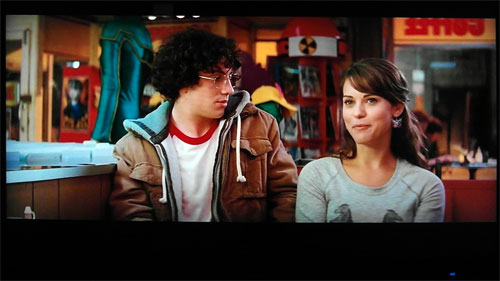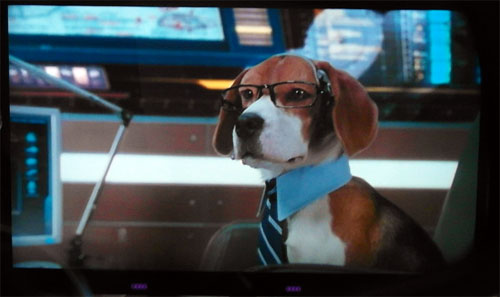Black Level
Calibrated black level on the Toshiba 46WL863B measured at a sufficiently deep 0.0447 cd/m2, putting it on par with this year’s LED TV offerings from Samsung and Sony. We did not witness any fluctuation in black levels, as long as [Auto Brightness Sensor Settings] and [LED Backlight Control] were both disabled, and [Black/White Level] was set to “0“.
Screen/Backlight Uniformity
The combination of edge LED backlight, slim profile and large screen size is traditionally a recipe for various uniformity issues, but thankfully the Toshiba 46WL863 (our review sample at least) seemed to buck this trend. When viewed straight on from 6 feet away, the screen was about as consistent as we could have hoped for. The sides did appear very marginally – and we do mean very marginally – lighter than the centre, but to our delight there was nary a hint of clouding nor flashlighting. We noticed several darker vertical bands once we moved beyond 45° off-axis, but to be honest these never troubled us (even in panning shots) as long as we did not sit too wide away from the sweet spot.
Standard Definition
Given that the Toshiba WL863 does not offer any [Film Mode] option in its user menu, we were not surprised to find that the television failed to detect and process 2:2 cadence over 576i, nor 3:2 over 480i. We strongly recommend that users feed the 46WL863B with progressive video signals (i.e. let the source device instead of the TV perform film-mode deinterlacing) when watching standard-def movies to avoid seeing artefacts like moire, jaggies and line twitter.
Moving on to video-mode deinterlacing, the Regza 46WL863 acquitted itself well – jaggies were by and large smoothened effectively, though some minor ones did surface from time to time. The quality of scaling/ upconversion was quite decent too: all the details in the SMPTE RP-133 test card were captured in full and displayed crisply albeit with some mild horizontal ringing around high-contrast edges.
Of course, engaging [Resolution+] – the company’s edge enhancement algorithm – would boost perceived sharpness, but at the price of exaggerating the aforementioned ringing as well as circumferential artefacts such as mosquito noise. For soft SD material, sprinkling in some of this [Resolution+] technology can be beneficial, but we would probably not go any higher than a [Level] setting of “2“.
High Definition
Armed with deep blacks plus reference-level greyscale and gamma made possible by 10-point white balance calibration, the Toshiba 46WL863B did full justice to HD content, showering them with a captivating sense of “pop” and realism seldom seen on lesser displays. With [Picture Size] set to “Native” to attain 1:1 pixel mapping, and without any underhanded film grain smoothing nor edge enhancement at play, 1080 images absolutely dripped with detail on the WL863 which faithfully delivered all the intended subtleties directly to our eyes.

Our only concern (and a small one at that) relates to the HDTV’s undersaturated portrayal of the colour red. While watching the superhero comedy movie Kick-Ass, we observed that Red Mist’s leather outfit, cape and his Ford Mustang-based Mist Mobile lost some of their fiery lustre as depicted on the Toshiba 46WL863. Fortunately, in real-world viewing most people probably won’t be able to spot this deficiency in red saturation outside of a side-by-side comparison with a reference display.
1080p/24 signals from Blu-ray films were handled competently – there was no evidence of telecine judder even with [Active Vision M800] disabled. The said motion-compensated frame interpolation (MCFI) system comes in two strengths: “Standard” and “Smooth“. The latter would introduce unmistakable soap opera feel to film material, which is generally a big no-no for movie enthusiasts. We didn’t really mind the [Active Vision M800] “Standard” setting which maintained the filmic quality of 24p movies very well while boosting the clarity of moving objects, but we did catch a few rare instances of video-like effect with certain scenes.
3D
Underpinned by inky blacks (further enhanced by the darkening effects of 3D eyewear) and D65 greyscale (painstakingly obtained through calibration using the onboard white balance controls which were thankfully available in 3D mode too), extra-dimensional viewing was a revelation on the Toshiba 46WL863B. To videophiles who wish to maximise their enjoyment of 3D content, we simply cannot overemphasise the merits of 3D calibration, particularly to compensate for any tint on the 3D glasses that will be inadvertently added to the picture you see. The calibrated Toshiba WL863 is working proof that you do not need to put up with overly frosty or ruddy flesh tones when watching tri-dimensional material.

We did not expect the Toshiba 46WL863 – being an LCD-based 3D TV – to be free from crosstalk (double ghost image caused by leakage of transmission intended for one eye to the other), but we were surprised by the alarming frequency at which this pleasure-spoiling artefact reared its ugly head especially with side-by-side (SBS) 3D content. The 3DTV did not cope well with SBS material – our own 3D resolution test pattern revealed soft scaling which was accompanied by visible ringing. And because of the absence of film cadence detection on the WL863, line twitter and jaggies could be seen on movies presented using the side-by-side method, for example those broadcast on the Sky 3D channel. As a result of these issues, we found side-by-side presentation on the 46WL863B lacking not only in crispness but also depth.
One positive thing we can say about watching Sky 3D on the Toshiba 46WL863 is that the television handled 50Hz 3D programmes without any judder. With 24fps movies from 3D Blu-ray discs though, we detected a hint of telecine judder, which was very subtle and really only noticeable during slow camera pans. Although we failed to eliminate the judder even after engaging [3D Judder Cancellation], we feel that this is something we can live with, especially given how good 3D Blu-ray movies looked on the WL863 (crosstalk was considerably less than in side-by-side mode).
Console Gaming
Toshiba Regza HDTVs we’ve reviewed over the past couple of years have always been gamer-friendly when it comes to input lag, and the 46WL863B is no different. In [Game] picture mode, we measured input lag on the LED LCD TV to be 31ms versus a reference CRT display, which is perfectly acceptable for all but the most lag-sensitive of hardcore gamers.
Conclusion
Although we were slightly disappointed that the all-singing all-dancing 55ZL1 never made it to the UK, the Toshiba WL863 proved itself to be a worthy next-in-line. The Regza 46WL863B competes well against flagship models from other major TV brands, with the star of the show being its exemplary greyscale and gamma performance after calibration, in both 2D and 3D.
Despite its lacklustre presentation of side-by-side 3D content, inability to fully saturate red, and deficiency in film cadence detection, we still think the Toshiba 46WL863 warrants recommendation as a package, taking into account its deep blacks, reference-level greyscale and gamma, impressive screen/backlight uniformity, decent CEVO-powered video processing, and last but not least Jacob Jensen-inspired designer makeup.

| Back to: 46WL863B Review |


Show All Comments